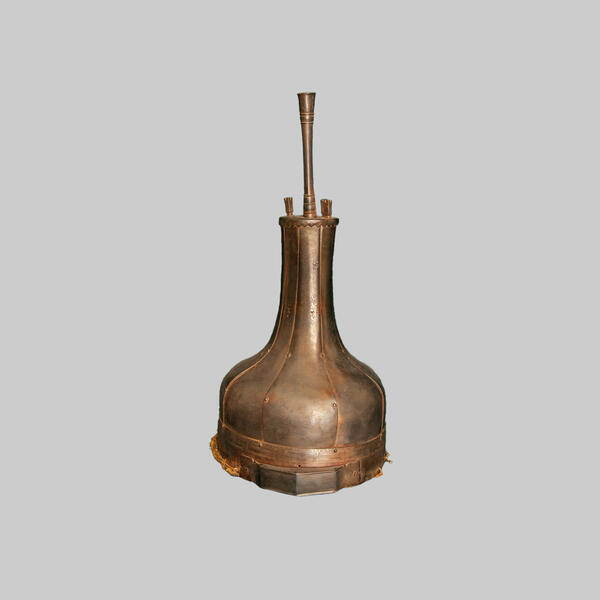There was no developed production of defensive weapons on the territory of Western Siberia during the late Middle Ages — Modern Ages. Local nobility often used products made on the territory of Central Asia. The helmet, which is kept in the exhibition of the Tobolsk Museum Reserve, is also of Asian descent. Mongolian and Dzungarian helmets of that time, known from the Museum collections of Russia, Mongolia and China, are divided into two types by the shape of the dome — sphero-conical and spherical with a cylindrical crown. The sample from the Tobolsk Museum Reserve belongs to the second type. This is a unique helmet, since it has no analogues in famous collections.
The helmet is made of iron. Its crown is riveted from 8 plates, from the bottom it is tied with a wide hoop, in which holes are made for attaching a camail — a flexible cape that protects the neck and shoulders of a warrior. This part of the armour is almost completely lost, only small fragments of cloth and narrow leather straps for fastening have survived. Camail was made by mail weaving, but the presented sample probably had a plate one. The top of the plate was bent and riveted to a flat round crest, on which other details were fixed: a high tube in the center, and on the sides — four (one lost) small bushes for plumages. A visor and a nasel were attached to the hoop on the front (it also did not survive), which went through the visor and was held by a screw. The helmet is decorated with an engraved ornament.
Such ‘fanciful-shaped’ helmets are presented in the collection of the Armoury Museum in Moscow. There they date back to about the 17th-18th centuries, they are attributed to the protective weapons of Oirat and Mongol warriors. Due to this similarity, historians suggest that the exhibit of the Tobolsk Museum Reserve actually belonged either to the Oirats who had been living in Sredniy Priirtysh for almost the entire 17th century, or to local Tatar lords who tried to find help from the Dzungarian Khanate during the struggle against Russian colonization. The latter version seems more likely, since the bulk of weapons items was delivered to the Museum’s funds in the early 20th century from local residents.
The helmet is made of iron. Its crown is riveted from 8 plates, from the bottom it is tied with a wide hoop, in which holes are made for attaching a camail — a flexible cape that protects the neck and shoulders of a warrior. This part of the armour is almost completely lost, only small fragments of cloth and narrow leather straps for fastening have survived. Camail was made by mail weaving, but the presented sample probably had a plate one. The top of the plate was bent and riveted to a flat round crest, on which other details were fixed: a high tube in the center, and on the sides — four (one lost) small bushes for plumages. A visor and a nasel were attached to the hoop on the front (it also did not survive), which went through the visor and was held by a screw. The helmet is decorated with an engraved ornament.
Such ‘fanciful-shaped’ helmets are presented in the collection of the Armoury Museum in Moscow. There they date back to about the 17th-18th centuries, they are attributed to the protective weapons of Oirat and Mongol warriors. Due to this similarity, historians suggest that the exhibit of the Tobolsk Museum Reserve actually belonged either to the Oirats who had been living in Sredniy Priirtysh for almost the entire 17th century, or to local Tatar lords who tried to find help from the Dzungarian Khanate during the struggle against Russian colonization. The latter version seems more likely, since the bulk of weapons items was delivered to the Museum’s funds in the early 20th century from local residents.



